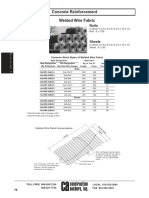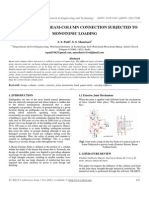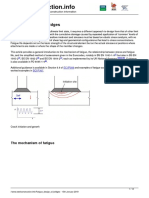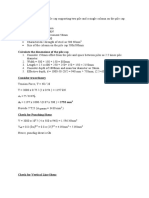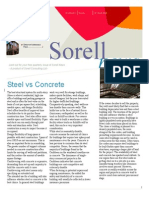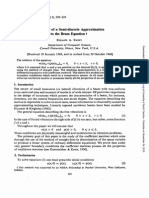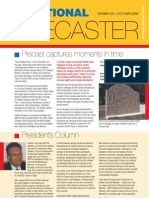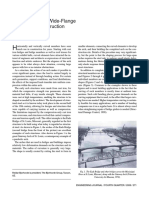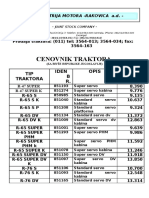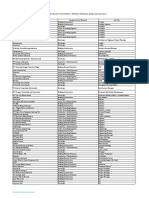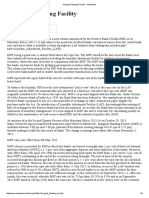Bending Radius
Bending Radius
Uploaded by
sexmanijakCopyright:
Available Formats
Bending Radius
Bending Radius
Uploaded by
sexmanijakOriginal Description:
Original Title
Copyright
Available Formats
Share this document
Did you find this document useful?
Is this content inappropriate?
Copyright:
Available Formats
Bending Radius
Bending Radius
Uploaded by
sexmanijakCopyright:
Available Formats
ENGINEERING JOURNAL / FOURTH QUARTER / 2006 / 271
H
orizontally and vertically curved members have seen
much use in construction for years. Starting with cast
iron bridges and bridge members as well as roof trusses for
various exhibit halls, curved elements have attracted the in-
terest of engineers and architects as expressions of structural
function and artistic endeavor. But the elegance of the arch
appears to be what always drew attention, covering large
spaces with few or no interior obstructions.
As a structure, the action of an arch makes it possible to
cover signicant spans, since the load is carried largely in
compression instead of through bending action. For certain
arch geometries, support conditions, and load distributions,
the effects of the imposed loads translate into uniform com-
pression within the entire arch.
The early arch structures were made from cast iron, for
which the compressive strength was paramount, since the
material had little, if any tensile strength. These elements
were cast at high temperatures, enabling the structure to be
shaped as needed by the architect. The development of struc-
tural steel as it is known today took place in the second half
of the 19th century, allowing for designs and structures that
were capable of carrying tension as well as compression.
The limitations imposed by the compression-only cast iron
were overcome, and structures evolved that carried compres-
sion and tension equally well. The oldest example is the Eads
Bridge of St. Louis, Missouri, generally regarded as the rst
structure to be built using what today is regarded as structur-
al steel. As shown in Figure 1, the arches of the Eads Bridge
(second bridge from the front of the picture) are excellent
examples of such structures. Also shown in Figure 1 is the
great Gateway Arch of St. Louis, a contemporary example of
a parabolic arch.
The arches that are used in bridges and buildings impose
relatively low deformation demands on the structure and its
materials. The radius of curvature is generally very large.
The shape is usually created by cutting the steel to form in
Cold Bending of Wide-Flange
Shapes for Construction
smaller elements, connecting the curved elements to develop
the arch, and then building the completed arch on the con-
struction site. Details of the procedure may vary signicant-
ly, but the point is that the shaping process for large-span
arches requires the steel only to undergo small plastic defor-
mations during the fabrication. In-service conditions entail
only elastic response demands for the arch, as is the case for
most structures.
In addition to complete structures such as arches, curved
structural members are also used extensively in construction,
and Figures 2 through 4 give some examples. Some of the
individual members are curved about the strong axis of the
shapes (Figures 2 and 4); others are curved about the weak
axis (Figure 3). Common to the examples shown in these
gures and to most building applications is the fact that the
curving of such members is mostly done at ambient tem-
perature. Such cold bending places greater demands on the
curving equipment that is used, to the effect that larger curv-
ing forces are needed. Higher temperature curving is certain-
ly feasible for many applications, and a number of bending
companies use it on a regular basis. It is almost always used
when straightening repair of bridge girders is needed (Struc-
tural Damage Control, 1998).
Reidar Bjorhovde is president, The Bjorhovde Group, Tucson,
AZ.
REIDAR BJORHOVDE
Fig. 1. The Eads Bridge and other bridges across the Mississippi
River at St. Louis, Missouri, along with the Gateway Arch (Princeton
University Art Museum, 1974).
272 / ENGINEERING JOURNAL / FOURTH QUARTER / 2006
For practical reasons the material that is presented focus-
es on applications of bent structural members for building-
type structures. Bridge structures rarely use members that
are curved as much as those described here, and fatigue and
similar considerations therefore need not be addressed.
STRAIGHTENING, CAMBERING, AND CURVING
Concepts and Applications
Straightening, cambering, and curving of structural shapes
are all representative of bending that involves local plasti-
cation of the steel to varying degrees. Although the principles
and basic mechanics of these processes are the same, they
are used for signicantly different purposes and with very
different magnitudes of bending deformations. The follow-
ing presents brief descriptions of these forming operations.
A detailed analysis of the large-deformation mechanics of
shape curving is given later in the paper, as well as practical
recommendations and limitations for cold curving of wide-
ange shapes.
While this work focuses on the curving of wide-ange
shapes, hollow structural sections (HSS) and other tubular
forms, as well as angles and channels, are also used for bent
construction. The bending mechanics theory applies equally
to these types of cross-sections, although certain specialized
conditions such as maintaining the geometry of a hollow sec-
tion during the curving operation also have to be addressed.
Changes in the depth through ovalization of a round tube,
for example, will inuence the stiffness of the element as a
structural component. This and other subjects have been ex-
amined in Dutch research work on the performance require-
ments for buried steel pipelines (Gresnigt, 1986).
Cold bending of plates exhibits some of the characteristics
of the processes that are addressed in this paper (Brocken-
brough, 2006). However, the degree of bending and the as-
sociated strain level is usually much higher, with bending
angles as large as 180. The geometric parameters are also
signicantly different.
Straightening
ASTM Specication A6/A6M gives detailed requirements
for bars, plates, shapes, and sheet piling used in construc-
tion (ASTM, 2006). Among these, the standard provides the
permitted variations for straightness for the various forms of
rolled shapes. For example, the maximum out-of-straight-
ness for wide-ange shapes with a ange width larger than
or equal to 6 in. is determined as
e = 8 [(number of feet of total length)/10]
which translates into approximately 1/1,000 of the length
of the shape. For the maximum out-of-straightness this cor-
responds to a radius of curvature of 12.5 times the actual
Fig. 2. Trolley terminal (photo courtesy of
Marks Metal Technology).
Fig. 3. Commercial structure (photo courtesy of
Max Weiss Company, Inc.).
Fig. 4. Commercial mall structure (photo courtesy
of Marks Metal Technology).
(1)
ENGINEERING JOURNAL / FOURTH QUARTER / 2006 / 273
length of the member. As a purely theoretical example, if a
member is 1,000 in. (approximately 83 ft) long, the maxi-
mum allowable value of e is 1 in. The radius of curvature is
therefore approximately 1,042 ft. Such a large radius entails
levels of bending strain that are extremely small.
The out-of-straightness requirement is the same for cam-
ber and sweep, which are the terms used for the out-of-
straightness measured relative to the strong and weak axes,
respectively. Figure 5 illustrates these two measurements
(Geschwindner, Disque, and Bjorhovde, 1994). It is empha-
sized that the term camber as dened by ASTM A6/A6M is
not the same as the camber that is sometimes used for beams
and girders in buildings to arrive at near-level oors after the
placement of concrete slabs.
Out-of-straightness is measured by the steel mill during
the production of the shapes, and straightening is applied to
make any nonconforming element meet the ASTM straight-
ness requirements. Depending on the size of the shape, the
straightening is either done in continuous fashion, or if
the shape is heavy, it is done through point application of
loads. The former procedure is referred to as roller or rotary
straightening; the latter is known as gag straightening. Both
involve local plastication of certain regions of the cross
section.
In rotary straightening the yielding takes place continu-
ously along the length of the shape, effectively altering the
residual stress distribution in the shape in such a fashion
that the strength of a wide-ange shape as a column is usu-
ally increased (Galambos, 1998). This is a side benet of
the rotary straightening process, although it is emphasized
that strengthening does not apply to all types of shapes, us-
ages, and straightener settings. Gag straightening causes lo-
cal yielding in the shape only in short segments along the
length of the member, surrounding each of the load appli-
cation points. This procedure has no effect on the column
strength of the shape. But common to both of these methods
is the fact that the amount of curving and the accompanying
strain demands within the cross section are very small, and
the radius of curvature of the bent member is very large.
Straightening of shapes to meet delivery standards is used
by all of the worlds steel mills. The methods and results
are the same, and the equipment that is used operates on
the same principles and applications. Figure 6 shows rotary
straightening equipment; Figure 7 pictures a gag straighten-
ing press.
Fig. 5. Denitions of camber and sweep for wide-ange shapes.
Fig. 6. Rotary straightening equipment (photo courtesy
of Nucor-Yamato Steel Co.).
Fig. 7. Gag straightening equipment (photo courtesy
of Nucor-Yamato Steel Co.).
274 / ENGINEERING JOURNAL / FOURTH QUARTER / 2006
Because of the way the rotary straightening rolls are
applied to certain areas of a wide-ange shape, with the
edges of the rolls resting on or near the llet between the
ange and the web, the region near the llet that is known
as the k-area develops higher strength and hardness as well
as lower ductility and toughness than other regions of the
shape. This is prompted by high shear yield strains in the
through thickness direction at this location within the shape.
The higher material strength and lower toughness have no
effect for the overall strength of the member as a column or
a beam. However, it has to be borne in mind when detailing
certain types of welded connections, to the effect that welds
should not be terminated in or near the k-area (Iwankiw,
1997; Bjorhovde, Goland, and Benac, 2000; Kaufmann and
Fisher, 2001; Lee, Cotton, Dexter, Hajjar, Ye, and Ojard,
2002; Hajjar, Dexter, Ojard, Ye, and Cotton, 2003; Chi and
Uang, 2004).
Cambering
For a structural engineer, cambering a beam means to pre-
bend the member in the direction opposite to the deec-
tion that will be developed by the anticipated gravity loads
(Ricker, 1989; Larson and Huzzard, 1990). In this context
the gravity loads usually mean the dead load. The aim is to
have a structural component that is horizontal or nearly so
following the application of the most closely known load
component. Since the dead load generally is known more ac-
curately than the live load, for example, cambering is almost
always done to an extent that equals a fraction or even all of
the dead load deection.
The loads being considered are all at service levels, mean-
ing that the deections are expected to occur during the op-
eration of the building. The most commonly used live load
deection limit equals the span divided by 360; dead load
deections may be on the same order of magnitude or some-
what larger. For a 30-ft-long simply supported beam, these
values come out as deections of approximately 1 in. It is
therefore understood that the amount of curving that has to
be done to counteract a dead load deection of 1 in. for a 30
ft span is very small, and the corresponding radius of curva-
ture is very large.
Structural cambering can be accomplished through selec-
tive heating of areas of the shape, or, as is most common,
through gag pressing the member at ambient temperature
while it is installed in a cambering frame (Ricker, 1989).
Cold cambering does involve plastication of small areas of
the cross section, similar to gag straightening, as discussed
previously. But the accompanying deformation demands for
the steel in the shape are very small, and the force(s) neces-
sary to develop the camber curve tends to be fairly small.
Studies by Gergess and Sen (2005a, 2005b) have dealt
with cold bending of symmetric and unsymmetric cross-section
plate girders. Because of the depth of the girders, the lack of
symmetry of some of the cross sections as well as the bend-
ing about the weak axis for some of the girders, the correla-
tion to what is presented here for hot-rolled W-shapes is lim-
ited. The Gergess and Sen studies also made use of a single
load application point. The associated radius of curvature is
therefore much larger than what is applied to the W-shapes
of the study presented here.
On the other hand, while the deformation and force de-
mands associated with cambering are small, it is important
to bear in mind the modications of the cross-sectional area
that will occur as a result of punching or drilling of holes
and similar fabrication operations. Some fabricating shops
are set up such that hole punching occurs at the beginning
of the various operations, with the cambering done at a later
stage. The cross-sectional area changes associated with hole
punching or drilling can create a preferred plane for yield-
ing, with the potential for localized failure (excessive defor-
mations or even fracture in the net section) during the cold
cambering process. This issue is further addressed later in
this paper.
Curving
Curving or bending of steel members for structures such as
those shown in Figures 2 through 4 involve substantial de-
formations and local plastication demands for the steel. It
can be applied about the strong or weak axes of the shapes,
depending on the structural requirements, to satisfy the ar-
chitectural or engineering designs. The curving is typically
performed to meet specic radii or other geometric congu-
rations.
The strong axis stiffness of shapes is the largest, and the
corresponding bending requirements are therefore the most
demanding. The bending commonly entails large axial strains
in the extreme bers of the cross section. The procedure also
involves local (point) application of forces from the bending
equipment, with subsequent potential for local web or ange
buckling of the shape or even overall lateral-torsional buck-
ling of the member during the curving operation. In extreme
cases, parts of the cross section may even undergo fracture.
This has been observed in a number of actual curving cases,
including one where the beams had been subjected to axial
strains more than 19 times the yield strain of the steel. It has
also occurred in members where local ange bending led to
web buckling, which in turn caused a crack to develop in the
ange close to the web-ange intersection. Similar failure
scenarios have been observed in several cases.
The most common equipment that is used by bending
companies focuses on passing the member through a set of
rolls that gradually deform the shape into a circle (most com-
monly) with the required radius. The basic principle is illus-
trated in Figure 8, whereby forces are applied via the rolls on
either side of the member. The shape is fed through the ma-
chine on repeated passes, with each one bending the member
ENGINEERING JOURNAL / FOURTH QUARTER / 2006 / 275
into successively smaller radii of curvature. Some machines
also utilize rolls on the tension ange of the W-shape, to
provide additional restraint against local ange bending as
the curvature gets smaller. This is especially important for
shapes with small web thicknesses (Steel Construction Insti-
tute, 2002). In Figure 8 the large rolls are the usual elements
in the bending machine; the small (dashed outline) roll is
actually a pair that is applied to the tension ange on both
sides of the web.
The bending process indicated by the rolls in Figure 8 is
the most common, but there are machines and bending com-
panies that do not rely on such rolls. Certain patented pro-
cesses utilize an articulated mechanism that distributes the
load over a larger region than what is possible with the rolls.
This is particularly the case for the smaller (tension ange)
roll, which these processes do not use. A key feature of other
curving operations is the use of restraining elements that pre-
vent ange bending and web buckling, thereby allowing for
smaller curving radii than what would otherwise be required.
Some of the bending problems that are described here are
therefore much less prevalent for the no-rolls and the re-
straint equipment operations, and the radius data that are
described below can be expanded to include smaller radii.
Bending companies also provide curved elements with
noncircular geometries. These may include elliptical forms,
combinations of circles and ellipses, and members that are
eventually made into S-type curves. However, such is usually
achieved by joining elements that have been curved in oppo-
site directions. An example of the latter is shown in Figure 9.
BENDING EQUIPMENT AND APPLICATIONS
There are a number of manufacturers of bending equipment,
but the Swedish company Roundo is possibly the best-known
supplier. Several bending companies use machinery of their
own design, and certain rms have patented equipment and
processes.
Figures 10 and 11 show two of the Roundo models and
Figures 12 through 15 give additional examples of bending
applications.
Fig. 8. Principle of bending process for shapes.
Fig. 9. Structure with members curved in opposite directions
(photo courtesy of Marks Metal Technology).
Fig. 10. Bending machine, Roundo model R3
(photo courtesy of Comeq, Inc.).
Fig. 11. Bending machine, Roundo model R-15-S
(photo courtesy of Comeq, Inc.).
276 / ENGINEERING JOURNAL / FOURTH QUARTER / 2006
CURVING MECHANICS AND ANALYSIS
Basic Concepts
As has been indicated for several applications of bending
shapes into permanent curves, a certain amount of plastic
deformation must take place in the cross section during the
process in order for the curving operation to work. Elastic
stress analysis and bending will not sufce, since any de-
formations taking place under such conditions will revert to
zero once the applied force or moment is removed. Further,
it has already been emphasized that bending about the strong
axis of the member, also referred to as bending the hard way,
is more demanding, because of the larger shape depth and
distance to the extreme bers in the cross section, as well as
the larger bending stiffness. Finally, curving may be done
to have a nal product in the form of a circle or part of one;
this can be arranged in many ways to arrive at combined
geometric forms. However, the bending machinery is most
commonly used to develop the circular form, for any number
of reasons.
Using the principles of mechanics of materials, classical
bending theory implies that to arrive at a circular form, a
constant moment is developed along the full length of the
member. Since the rst derivative of the moment is the shear
force and the moment is a constant, shear force, stresses, and
strains will be zero. Only exural stresses and strains will
develop in the cross section under these conditions.
However, it is important to recall that transverse forces
are developed by the rollers used in the bending machine
(see Figure 8). These produce local compressive stresses in
the web of the shape. Further, and especially with small ra-
dii, the curving operation has a tendency to promote local
bending of the tension ange of the shape, which in turn
may promote the possibility of local web buckling. Both of
these phenomena can be somewhat controlled by careful
alignment of the shape in the curving machine, but if the
web of the shape is very thin, local buckling can be avoided
by limiting the magnitude of the radius of curvature. The
use of restraints, as mentioned previously, to prevent or at
least delay the onset of ange bending and/or web buckling
can also enhance the bending capacity signicantly. The re-
straints facilitate the use of smaller bending radii.
Fig. 12. Curved W1253 shapes
(photo courtesy of Max Weiss Company).
Fig. 13. Curved W2144 shapes (photo courtesy
of Max Weiss Company).
Fig. 14. Wedding chapel (photo courtesy
of Marks Metal Technology).
Fig. 15. Industrial installation (photo courtesy
of Max Weiss Company).
ENGINEERING JOURNAL / FOURTH QUARTER / 2006 / 277
Finally, if local web buckling occurs and it is not promptly
discovered, chances are very good that the web or even the
ange may fracture as a result of the combination of com-
pressive stress in the web and the ange bending that accom-
panies the buckling action. Figures 16 and 17 demonstrate
web buckling and ange bending of a W1226 shape that
had been curved to a tight radius. Figure 17 shows the ange
actually broken away from the web. This occurred as a result
of the web buckling and the subsequent ange bending.
Material Properties of Curved Members
The mechanical properties of steel are based on the common
uniaxial tension test. This reects a consensus approach to
the properties of a wide range of materials and is very useful
when it comes to correlation and comparison between steels
from various producers. Of course, the tension test does not
represent the response characteristics of the steel in actual
structures, and was never intended to do so, but it is still a
practical tool for designers, fabricators, and other users of
the material.
As the beam is curved to the extent that plastic deforma-
tions occur in smaller or larger areas of the cross-section,
the yielded regions may undergo material property changes
as a result of the strains. As an example, Figure 18 shows
the stress-strain curve for the proverbial mild steel (ASTM
A36 in this case).
When the steel has been deformed plastically, it has un-
dergone permanent deformations that are not removed upon
unloading of the material (Bjorhovde, Engestrom, Grifs,
Kloiber, and Malley, 2001). This is indicated by the dashed
lines in Figure 18, to the right of the solid line initial stress-
strain curves in the diagram.
Upon reloading, the steel responds in accordance with the
dashed lines in the gures, seeming to indicate a material
with a yield stress and elongation properties as dened by
the new stress-strain curve. If there is only a small or even
no yield plateau, which is typical of higher strength materi-
als, the reloading response appears to be that of a steel ma-
terial with a yield stress that is larger and an elongation at
rupture that is smaller than the corresponding properties of
the original material. If the steel has been strained into the
strain hardening range, the change in the apparent mechani-
cal properties can be substantial (Brockenbrough, 1992).
This elastic-inelastic behavior of the steel must be con-
sidered when planning the curving operations for structural
shapes. It is taken into account in the curving criteria pre-
sented in the section entitled, Practical Criteria for Structur-
al Shape Curving. But specically, since a smaller or larger
part of the cross-section of the member must be deformed
Fig. 16. Wide-ange shape with buckled web and ange bending
(right side) (photo courtesy of Nucor-Yamato Steel Company).
Fig. 17. Wide-ange shape with buckled web and one-half of
ange broken off (photo courtesy of
Nucor-Yamato Steel Company).
Fig. 18. Stress-strain curve for typical mild structural steel.
278 / ENGINEERING JOURNAL / FOURTH QUARTER / 2006
plastically in order for the curving to work, the extreme -
bers in the cross section will be deformed well beyond the
level of the initial yield strain,
y
, of the steel. Depending on
the curving radius, the maximum strain is likely to exceed
the yield strain by a signicant amount. If the curving ra-
dius is too small, or if there are stress concentrations such as
holes in the ange(s) or coped areas of the beam, the mag-
nitude of the strain that is imposed by the curving operation
may reach the fracture level. This has been observed in a
number of actual curving cases at bending facilities, but it
has never been seen in the eld. In brief, therefore, once the
curving has been completed successfully, a failure due to the
bending operation will not occur after the member has been
placed into service. The exural strains the member will ex-
perience during service are within the elastic range of behav-
ior, and at least one order of magnitude smaller than those
associated with the curving. In terms of service load stress
levels, it is important to bear in mind that these stresses are
well below the yield stress, typically no more than half of
the yield level.
A study by Schlim (Schlim, 1987) used a range of curving
radii for shapes in 36 ksi steel that were 220 mm (8.8 in.)
deep. For a curving radius of 12.7 m (44 ft), which correlates
very well with the curving criterion developed here, it was
found that the yield and tensile strengths increased by about
10%; the elongation at rupture decreased by a small amount.
There was no measurable change in the fracture toughness,
as based on Charpy V-Notch tests. However, Schlim also
noted that curving to much smaller radii would result in sig-
nicant changes in the material properties.
Curving Mechanics
Curving Geometry
The curving is usually performed to meet a certain radius
required for the member. Sometimes only the length of
the span that is to be covered is given, and the offset of the
curved member is specied. Figure 19 illustrates this for an
element with a radius R, a span (in other words, circle chord
length) of c, and an offset of b.
The mathematics of the circle gives the following rela-
tionships:
The curving radius is the most important factor, since it de-
termines the moment, curvature and levels of strain that will
develop when the shape is bent to the specied congura-
tion.
Moments and Strains Developed by Curving Operation
Given the radius of the member to be curved, R, the curva-
ture, , is given by Equation 3.
For a constant radius for the full length of the member, the
moment-curvature relationship is dened by the expression
which gives the value of the constant moment along the
length of the member as
where
M
ce
= constant moment of the circular member when
the material and the shape behave elastically
E = modulus of elasticity
I = moment of inertia for the axis of bending
about which the shape is being curved
It is emphasized that the moment of Equation 5 reects
the elastic moment-curvature relationship. Since the curv-
ing operation necessitates a certain amount of plastication
of the shape, Equation 5 does not apply. For example, the
effective modulus of elasticity is zero for yielded material,
and the moment of inertia of the shape is reduced by the
loss of the stiffness contribution of the yielded areas of the
cross section. Equation 5 can be replaced by an inelastic
version, thus
Fig. 19. Circle with radius, chord length, and offset.
Offset: b R R c =
( )
2 4
2 2
(2a)
Radius: R
b c
b
=
4
8
2 2
(2b)
(3) =
1
R
(4)
= =
1
R
M
EI
(5)
M M
EI
R
ce
= =
(5a) M M
EI
R
ie
eff
= =
( )
ENGINEERING JOURNAL / FOURTH QUARTER / 2006 / 279
where
M
ie
= inelastic moment
(EI)
eff
= effective bending stiffness of the partially
yielded cross section
However, this is a cumbersome and less than practical ap-
proach, especially since the effective stiffness changes as the
radius changes.
For inelastic behavior, the moment-curvature expressions
of Equations 4 and 5 do not apply. In this case it is neces-
sary to go to the fundamental strain-curvature relationship,
which dictates that plane sections remain plane. Although it
is satised only approximately for curved members, it is suf-
ciently accurate for the applications addressed here.
For this case the following applies, as illustrated by the
strain distribution of Figure 20, using a doubly symmetric
cross section for the example (the linear strain distribution
applies for all types of shapes):
or
where
= strain at a distance y from the neutral axis
The linear strain distribution in Figure 20 applies for any
level of applied moment.*
The traditional linear stress distribution applies only when
all areas of the cross section are elastic, for which stress and
strain are related by Hookes Law, that is, = E .
For a doubly symmetric cross section, the maximum
bending strains occur at the top and bottom extreme bers,
thus
where
= rotation of the cross section, equal to the cur-
vature, = 1/R
At the point when yielding rst takes place,
max
=
y
=
F
y
/E, which reects the limit of elastic behavior. The yield
strain,
y
, and the corresponding yield rotation,
y
, are:
which occur for a moment equal to the yield moment, M
y
.
The yield and fully plastic moment capacities of the cross
section are:
M
y
= F
y
S
x
M
p
= F
y
Z
x
where
S
x
= elastic section moduli
Z
x
= plastic section moduli
For a given radius, R, the maximum strain in the cross
section is given by Equation 7, and the corresponding cross-
sectional rotation is
and
max
is reformulated as
*The principle of plane sections remain plane applies for all practical structural engineering issues. If very large bending or
shear deections occur, it does not. However, such considerations need not be made here.
Fig. 20. Linear strain distribution
over the depth of the cross section.
(6a)
= =
1
R y
(6b)
=
y
R
(7)
max
=
\
)
l
l
l
l
l
l
=
(
\
)
d
R
d
2
2
(8a)
y
y
F
E
=
(8b)
y
y
d
=
\
)
2
(9a)
(9b)
(10)
max
max
=
(
\
)
=
y
y
y
(11)
max
=
\
)
=
d
R
y
2
280 / ENGINEERING JOURNAL / FOURTH QUARTER / 2006
where
= the maximum strain factor
Equation 11 indicates that the maximum strain in the cross
section is a multiple, , of the yield strain,
y
. The maximum
strain value can now be compared to the stress-strain curve
for the material of the shape in question.
The strain and stress distributions in the cross section for
the required amount of curving can now be determined. The
stress distribution may then be used to calculate the magni-
tude of the curving moment, M
c
, taking into account the fact
that portions of the cross section have yielded.
Together with the yield and fully plastic moments and the
corresponding yield and fully plastic rotations, the moment-
rotation curve for the shape is then determined. The magni-
tudes of the curving moment and the corresponding rotation
serve as an illustration of the degree to which the shape has
been plastied.
Figure 21 shows a hypothetical strain and corresponding
stress distribution for a doubly symmetric cross section, not-
ing that the strain is larger than the yield strain
y
over the
two symmetrical portions of the depth, d
y
. The remaining
elastic portion of the cross section is the central area of depth
equal to 2(d/2 d
y
).
Figure 22 shows the resulting moment-rotation diagram
for the shape in question, including the data for the maxi-
mum rotation,
max
, that is being imposed by the curving
moment.
The size of the yielded portion of the cross section is de-
termined from the relationship (see Figure 21)
which gives
The actual magnitude of the curving moment, M
c
, can now
be found from the stress distribution shown in Figure 21b,
along with the respective areas of the cross section and their
moment arms.
Development of Curving Requirements
Based on the magnitudes of the maximum strains and rota-
tions, an assessment can now be made as to whether it is
feasible to curve the given shape and steel material to the
specied radius. As will be seen in the following, the smaller
the value of the maximum strain factor, the larger will be
the portion of the shape that remains elastic when the maxi-
mum curving moment (in other words, the target radius) is
applied. The value of dictates the reserve moment capacity
and hence the available ductility of the shape for the required
radius of curvature.
Obviously, there are pros and cons in choosing small or
large values, but the key considerations are as follows:
1. A small value of provides for larger reserve moment
capacity and therefore a larger margin of safety against
potential overstraining of the steel.
2. The smaller the value, the larger the radius that should
be used for a given shape.
3. A large value of leaves a smaller portion of the cross
section elastic by the time the target radius has been
reached. This may be acceptable to the engineer and the
curving company, but it is important to understand the
Fig. 21. Strain and stress distributions for
the specied radius of curving.
Fig. 22. Moment-rotation relationship for curved shape.
d
d
y
y
max max
( )
=
\
)
2
(12) d
d
y
y
=
( )
l
l
l
l
l
\
)
max
max
2
ENGINEERING JOURNAL / FOURTH QUARTER / 2006 / 281
implications of the small reserve moment capacity. Ac-
cidental overloads or curving to a smaller radius than the
required value in particular may result in steel fracture,
local buckling, or other failure while the member is being
curved at the bending facility.
4. Shapes with thin webs are particularly vulnerable to
web buckling for small reserve moment capacities and,
therefore, also to overstraining and fracture of the steel in
the web-to-ange region.
5. Flange and/or web restraint elements are effective in
preventing ange bending and web buckling. Such equip-
ment will allow for the use of a larger value, in other
words, a smaller radius of curvature. The restraints allow
the shape to be able to accommodate the kind of larger
maximum strains that are associated with smaller radii.
6. Overstraining and consequent overloading of a shape
through improper curving is more likely to occur for
lower strength steels. This is because the yield strain is
lower for such steels.
7. Pre-curving fabrication operations such as punching or
drilling of holes in the anges, coping of the anges,
and similar may provide areas of stress and consequently
strain concentrations, with the possibility of fracture of
the material at these locations. Such fractures have been
observed in several cases.
For structural steels with yield stresses of 36 and 50 ksi
and a modulus of elasticity of 29,000 ksi, maximum strain
factor limitations of 4, 6, 8, 10, 16, 24, and 36 correspond to
yield and maximum strain levels as illustrated below.
Yield Stress: F
y
= 36 ksi
y
= 0.00124 = 0.124%
= 4
max
= 0.00496 = 0.496%
= 6
max
= 0.00744 = 0.744%
= 8
max
= 0.00992 = 0.992%
= 10
max
= 0.0124 = 1.24%
= 16
max
= 0.01984 = 1.98%
= 24
max
= 0.02976 = 2.98%
= 36
max
= 0.04464 = 4.46%
Yield Stress: F
y
= 50 ksi
y
= 0.00172 = 0.172%
= 4
max
= 0.00688 = 0.688%
= 6
max
= 0.01032 = 1.03%
= 8
max
= 0.01376 = 1.38%
= 10
max
= 0.0172 = 1.72%
= 16
max
= 0.02752 = 2.75%
= 24
max
= 0.04128 = 4.13%
= 36
max
= 0.06192 = 6.19%
Expressing the equations in terms of the maximum level of
strain,
max
=
y
, the yielded portions of the cross section
become (see Figure 21),
and the central fraction of the web that remains elastic is
Checking for Web Buckling and Similar Limit States
The installation and alignment of the shape in the curving
machine are important considerations. These are very dif-
cult to have done exactly, since the actual support condi-
tions, the placement of the equipment rolls, etc., are rarely
known. However, the following checks should be made for
the shape by the structural engineer, as broad assessments of
the potential for local failures:
1. Web compression buckling (AISC Equation J10-8)
2. Web sidesway buckling (AISC Equations J10-6 and
J10-7)
3. Web crippling (AISC Equations J10-4 and J10-5a,b)
4. Web local yielding (AISC Equations J10-2 and J10-3)
The references to AISC give the equation numbers for the
respective limit states, as addressed in the AISC Specica-
tion for Structural Steel Buildings, hereafter referred to as
the AISC Specication (AISC, 2005).
Of the preceding four checks, the web compression buck-
ling (No. 1) and web sidesway buckling (No. 2) are the ones
most likely to indicate a potential local buckling problem
associated with the curving of the shape. It is also noted that
the application of No. 1 to the curving of a beam is conser-
vative.
In some actual cases, during curving at a bending facility,
web buckling has been found along with ange local bend-
ing. The ange bending was a result of the too-small radius
and the phenomenon described earlier. However, the large
axial strain demands imposed by the curving operation and
the web buckling were the driving forces, eventually hav-
ing caused the fracture of the web or the ange by through-
thickness bending. Flange and web restraints might have
eliminated these problems.
It has been noted that shapes with a larger web thickness
tend to perform better during the bending operation. The
increased web thickness provides a higher buckling strength
and hence less opportunity for transverse ange bending to
d
d
y
y y y
y
=
( )
l
l
l
l
l
\
)
=
( )
( )
max
max
2
ll
l
l
l
\
)
=
( )
l
l
l
l
\
)
d
d
2
1
2
(13)
Elastic portion = =
( )
l
l
l
l
EP 1
1
(14)
282 / ENGINEERING JOURNAL / FOURTH QUARTER / 2006
take place. As of 2005, there are no actual data or operational
suggestions that can be used to arrive at enhanced radii when
curving such shapes. An experienced bending company
should be approached for advice in these cases.
A nal comment is needed regarding gradually increasing
the plastication of the shape during the curving operation.
Most companies send a shape through the machine in sev-
eral passes, each of which imposes additional yielding of the
steel. This provides for curving cycles that demand smaller
roller forces for each pass. However, the process does not
limit the eventual maximum strains. In addition, since there
is only a small time lag between the individual bending
passes, issues such as strain aging most likely will not play a
role. However, this is very difcult to conrm or reject with-
out actual tests for material properties.
Some Other Considerations
The text has focused on the technical issues and potential
difculties associated with curving wide-ange shapes about
the strong axis at ambient temperature. These are the most
demanding conditions insofar as the material and the shapes
are concerned. Some other considerations are outlined in the
following.
Curving by Concentrated Load Application (Gag Pressing)
Depending on the available equipment in the bending shop,
curving by concentrated load application is sometimes per-
formed. The operation is similar to what is done for normal
cambering of beams as described previously, except that the
level of force and the amount of bending are signicantly
larger than the magnitudes associated with structural camber.
Using the model of a concentrated load applied centrally
to a simply supported beam, the moment distribution varies
linearly from zero at the supports to the maximum at the load
application point. The shear force is constant for each half of
the beam and equal to half of the applied load. The deection
is a maximum at mid-span.
The location of the maximum moment is also the location
of the maximum strain demand within the length of the beam.
Further, the deformation capacity of the steel is the smallest
when the member is subjected to a uniform moment along
the full length, or, in other words, when all cross-sections are
subjected to the same maximum strain demand. The latter
occurs for a beam that is bent to a constant curvature, when
the moment is a constant for the full length of the member.
It is clear that bending by cambering is at most as severe as
curving by constant radius bending. The strain demand at
the location of the maximum moment is always the critical
consideration. The performance requirements as dened by
the constant radius and the corresponding maximum strain
factor therefore apply equally to gag pressing.
Curving about the Weak Axis of W-Shapes
The bending mechanics approach and the equations that
have been developed here are equally applicable to the case
of weak axis bending of W-shapes. However, the strain
demands will be signicantly different, due to the smaller
dimension across the ange (as compared to the depth of
the shape) and the smaller moment of inertia. In theory,
a shape being bent about its weak axis will be able to ac-
commodate smaller curving radii. However, it is important
to bear in mind that the maximum strain will occur at the
ange tips, and that the ange tips are laterally unsupported.
That is, the anges are unstiffened and will be subjected
to exural strains and stresses whose values are zero at the
level of the web. For smaller ange thicknesses and/or larger
ange widths the potential problem of ange buckling (in a
direction transverse to the centroidal axis of the shape) must
be addressed. This is a situation similar to having the web
(stem) of a tee shape subjected to compression.
Section B4 (Table B4.1) of the AISC Specication for
Structural Steel Buildings (AISC, 2005) details the criteria
for compactness of shapes. A compact shape by denition is
capable of reaching the fully plastic moment and to sustain
signicant plastic rotation before local buckling or strain
hardening occur. However, compactness does not guarantee
that the shape can be curved to any radius. The compactness
concept and criteria were not developed with shape curv-
ing in mind. Further stability considerations are presented
in the Guide of the Structural Stability Research Council
(Galambos, 1998).
Curving Other Types of Shapes
Channels, tees, angles, and various hollow structural sec-
tions (HSS) are sometimes used in curved applications. The
basic mechanics criteria also apply to these types of shapes,
although some special considerations need to be made for
local buckling of outstanding legs and anges, unstiffened
anges, stems and angle legs, and the shape of circular and
square/rectangular HSS. The AISC Specication provides
width-to-thickness criteria for the plate elements of these
shapes (AISC, 2005); however, other local buckling and
stability assessments can be made for the individual types
of shapes.
Considerations for Pre- and Post-Curving Operations
The curving model determines the requirements to deform a
shape to the desired curvature. The forming operations can
create areas of higher strain in the shape than predicted by
the model. Local areas of higher plastic strains (for example,
when small amounts of web or ange buckling occur) can
inuence the ability to perform post-curving operations such
as coping or galvanizing. Any post-curving operations need
ENGINEERING JOURNAL / FOURTH QUARTER / 2006 / 283
to be considered when selecting a value for the maximum
strain factor and may necessitate the use of a more conserva-
tive (in other words, smaller) value of .
Bracing members or purlins are sometimes attached to the
outside ange of a curved member, most commonly by bolts.
It is recommended that bolt holes in the ange of a curved
shape be made after the curving has been completed, even
if this may be somewhat inconvenient. The stress concentra-
tions associated with the holes may create additional strain
limitations for the material in the anges, and fractures have
been known to occur at the exact locations of the bolt holes.
However, if the curving is completed rst, no difculties are
anticipated. It is known that this approach has been used suc-
cessfully.
Galvanizing is sometimes used to provide corrosion pro-
tection for curved members that will be exposed to the envi-
ronment during regular service. This is effectively a form of
heat treatment, and although difculties have been reported
in some cases, there are no hard data that can be used to
analyze the inuence of the galvanization. Most applications
have been successful, as reported by the industry, but careful
inspection of post-galvanizing is very important.
PRACTICAL CRITERIA FOR
STRUCTURAL SHAPE CURVING
Development of Criteria
The following parameters are paramount in the initial as-
sessment of the curving needs for wide-ange structural
members:
1. Radius of curvature, R
2. Depth of shape, d
3. Yield stress of steel, F
y
In addition, to prevent excessive straining of the steel and
to ensure a minimum of reserve bending capacity of the
shape:
4. Maximum strain factor,
5. Maximum bending strain,
max
=
y
With the maximum strain factor of , this gives:
which means that the minimum curving radius must satisfy
the following criterion:
and substituting for
y
= F
y
/E, this gives
With the value of E as 29,000 ksi, this gives the basic
curving criterion, thus
with R and d expressed in inches and F
y
in ksi. The maximum
strain factor is dimensionless.
The limiting radius is used here for the curving criterion,
not the least because of the physical illustration that is pro-
vided by the radius. It is possible to express the curving cri-
terion in terms of the maximum longitudinal strain, which is
given directly by the magnitude of maximum strain factor.
An value of 8, for example, implies a maximum total strain
of 8
y
. Another denition might be to use the total plastic
strain that is developed during curving, especially when it
is done to repair damaged girders (Brockenbrough and Bar-
som, 1992). However, it is felt that the radius approach is
preferable.
Sample Limits of Curving Using
the Basic Curving Criterion
The following data are given only as examples of the radii
that are implied for two grades of steel and two values of the
maximum strain factor. Again, it is noted that the radii that
are used for the higher strength steel are smaller than those
that can be used with the lower strength material (in other
words, higher strength implies higher curving capacity for
otherwise identical shapes).
1. 50 ksi yield stress steel and = 8:
R > 36.25d
d = 12 in. R > 435 in. = 36 ft
d = 18 in. R > 653 in. = 54 ft
d = 24 in. R > 870 in. = 73 ft
d = 30 in. R > 1,088 in. = 91 ft
d = 40 in. R > 1,450 in. = 121 ft
2. 36 ksi yield stress steel and = 8:
R > 50.35d
d = 12 in. R > 604 in. = 50 ft
d = 18 in. R > 906 in. = 76 ft
d = 24 in. R > 1,208 in. = 101 ft
d = 30 in. R > 1,511 in. = 126 ft
d = 40 in. R > 2,014 in. = 168 ft
max
= =
\
)
y
d
R
2
R
d
d
y y
\
)
=
( )
2
2
R
d
F
E
dE
F
y y
\
)
l
l
l
l
=
( )
( )
2
2
(15)
R
d
F
y
( )
l
l
l
l
l
14 500 ,
(16)
284 / ENGINEERING JOURNAL / FOURTH QUARTER / 2006
3. 50 ksi yield stress steel and = 12:
R > 24.2d
d = 12 in. R > 290 in. = 24 ft
d = 18 in. R > 426 in. = 36 ft
d = 24 in. R > 581 in. = 48 ft
d = 30 in. R > 726 in. = 61 ft
d = 40 in. R > 968 in. = 81 ft
4. 36 ksi yield stress steel and = 12:
R > 33.6d
d = 12 in. R > 403 in. = 34 ft
d = 18 in. R > 605 in. = 50 ft
d = 24 in. R > 806 in. = 67 ft
d = 30 in. R > 1,008 in. = 84 ft
d = 40 in. R > 1,344 in. = 112 ft
These data reect the rst and most important check for curv-
ing capacity, taking into account the properties of the steel as
well as the key dimension of the shape. It is emphasized that
these data are based on unrestrained steel shapes, without the
use of restraint equipment or tensile force application, as is
done in some processes.
It is recommended that if an value larger than 12 is be-
ing considered, advice should be sought from an experienced
bending company.
The basic curving citerion demonstrates that the larger
the depth of the shape, the larger the curving radius must
be in order to avoid overstrain. Similarly, for two otherwise
identical shapes, the one with the lower yield stress steel
requires a larger curving radius to avoid overstrain, simply
because yielding will occur at a smaller moment than it will
for the higher strength material. In other words, overstrain-
ing is more likely to occur in lower strength steel, as would
be expected.
The second stage of checking by the structural engineer
requires an evaluation of the potential for web compression
buckling and web sidesway buckling, as outlined earlier.
SUMMARY
These guidelines present a discussion of current cold bend-
ing practices for hot-rolled steel wide-ange shapes for ap-
plication to building-type structures, with illustrations using
a number of current projects. The criteria do not apply to
stainless steel.
A theoretical formulation has been developed to empha-
size that the key consideration for shape bending is the strain
demand that will be imposed on the material. Following fun-
damental moment-curvature relationships and aiming for a
certain maximum strain in the extreme bers of the cross
section, the basic curving criterion has been developed. The
expression is a simple relationship between the radius of
curvature, the depth of the shape, the yield stress of the steel
and the maximum strain factor. It is also noted that other
limit states need to be evaluated. Practical applications of
the basic curving criterion may focus on a range of suitable
curving radii. The radius depends on the preferences and ex-
perience of the bending contractor, as well as the equipment
that is used.
When a shape has been curved successfully, with no buck-
ling or localized cracking in the steel, the strains the member
will experience under actual service conditions will be much
smaller than those associated with the curving operation.
Once the curving is done, the member can be expected to
perform as intended.
Although the focus of the guidelines has been on the use
of wide-ange shapes bent about their strong axis at room
temperature, the basic curving criterion applies equally to
other cross-sections. However, for such other shapes addi-
tional attention must be given to the potential limit states
that may inuence the response of the cross-section during
bending.
Developments in bending equipment and techniques con-
tinue to improve and expand the capacities of companies to
curve shapes to increasingly tighter radii. Maintaining sec-
tional integrity with minimal distortion and avoidance of lo-
calized material failures will aid in providing bent members
that will perform effectively in service. Additional research
studies may be warranted to continue to expand the offerings
of bending companies.
The analyses and the criteria that have been developed are
not intended for application with structures that are subjected
to high-cycle loads, such as bridges.
ACKNOWLEDGMENTS
Sincere appreciation for detailed and very useful comments
on the study presented in this paper are extended to the
members of the AISC Rollers and Benders Committee, in
particular George Wendt, committee chair, Allan Flamholz,
David Marks, Joe Rogers, and Ray Weiss. Additional thanks
are due the Technical Committee on Structural Shapes, in
particular Mike Engestrom, and to numerous Nucor-Yamato
Steel Company staff members.
NOMENCLATURE
E = modulus of elasticity
(EI)
eff
= effective bending stiffness of a partially yielded
cross section
EP = remaining elastic portion of cross section
F
y
= yield stress of steel
I = moment of inertia
M = bending moment (general)
ENGINEERING JOURNAL / FOURTH QUARTER / 2006 / 285
M
c
= curving moment
M
ce
= elastic constant moment of a circular beam seg-
ment
M
ie
= inelastic moment
M
p
= fully plastic moment of a cross section
M
y
= yield moment
R = radius
S
x
= elastic section modulus of cross section about the
x-axis
Z
x
= plastic section modulus of cross section about the
x-axis
b = offset of a circle segment
c = chord length of a circle segment
d = depth (height) of beam
d
y
= yielded portion of cross section
e = initial out-of-straightness
t
w
= web thickness
y = coordinate within beam cross section
= maximum strain factor
= strain
max
= maximum strain within cross section
y
= yield strain
= rotation of cross section
max
= maximum rotation of cross section
p
= rotation of cross section upon reaching fully plas-
tic moment
y
= rotation of cross section upon reaching yield mo-
ment
= curvature
= stress
REFERENCES
AISC (2005), Specication for Structural Steel Buildings,
ANSI/AISC 360-05, March 9, American Institute of Steel
Construction, Inc., Chicago, IL.
ASTM (2006), Standard Specication for General Require-
ments for Rolled Structural Steel Bars, Plates, Shapes,
and Sheet Piling, ASTM A6/A6M, American Society for
Testing and Materials, West Conshohocken, PA.
Bjorhovde, R., Goland, L.J., and Benac, D.J. (2000), Per-
formance of Steel in High-Demand Full-Scale Connec-
tion Tests, Proceedings, 2000 North American Steel Con-
struction Conference, Las Vegas, NV, February 2326, pp.
3-13-22.
Bjorhovde, R., Engestrom, M.F., Grifs, L.G., Kloiber, L.A.,
and Malley, J.O. (2001), Structural Steel Selection Con-
siderationsA Guide for Students, Educators, Design-
ers and Builders, American Society of Civil Engineers,
Reston, VA, and American Institute of Steel Construction,
Chicago, IL.
Brockenbrough, R.L. and Barsom, J.M. (1992), Metal-
lurgy, Chapter 1.1, Constructional Steel DesignAn
International Guide, P.J. Dowling, J.E. Harding, and
R. Bjorhovde, Eds., Elsevier Applied Science, London,
England, pp. 116.
Brockenbrough, R.L. (1992), Material Properties, Chapter
1.2, Constructional Steel DesignAn International Guide,
P.J. Dowling, J.E. Harding, and R. Bjorhovde, Eds., Else-
vier Applied Science, London, England, pp. 1732.
Brockenbrough, R.L. (2006), Development of Fabrica-
tion Guidelines for Cold Bending of Plates, Engineering
Journal, Vol. 43, No. 1, pp. 4956.
Chi, B. and Uang, Chia-Ming (2004), Effect of Straight-
ening Method on the Cyclic Behavior of k-Area in Steel
Rolled Shapes, Engineering Journal, Vol. 41, No. 1, pp.
1522.
Galambos, T.V., Ed. (1998), Guide to Stability Design Crite-
ria for Metal Structures, 5th ed., Wiley-Interscience, New
York, NY.
Gergess, A.N. and Sen, R. (2005a), Fabrication of Unsym-
metrical Curved Plate Girders by Cold Bending, Jour-
nal of Constructional Steel Research, Vol. 61, No. 10, pp.
13531372.
Gergess, A.N. and Sen, R. (2005b), Cold Curving Sym-
metric Unstiffened I-Girders, Journal of Constructional
Steel Research, Vol. 61, No. 4, pp. 473492.
Geschwindner, L.F., Disque, R.O., and Bjorhovde, R. (1994),
Load and Resistance Factor Design of Steel Structures,
Prentice-Hall, Englewood Cliffs, NJ.
Gresnigt, A.M. (1986), Plastic Design of Buried Steel Pipe-
lines in Settlement Areas, Heron, Delft University of
Technology, Delft, the Netherlands, Vol. 31, No. 4.
Hajjar, J.F., Dexter, R.J., Ojard, S.D., Ye, Y., and Cotton, S.C.
(2003), Continuity Plate Detailing for Steel Moment-
Resisting Connections, Engineering Journal, AISC, Vol.
40, No. 4, pp. 8197.
Iwankiw, N.R. (1997), AISC Advisory Statement on Me-
chanical Properties Near the Fillet of Wide-Flange Shapes
and Interim Recommendations, Modern Steel Construc-
tion, Vol. 37, No. 2.
286 / ENGINEERING JOURNAL / FOURTH QUARTER / 2006
Kaufmann, E.J. and Fisher, J.W. (2001), The Effect of
Straightening Method on the k-Area Loading Behavior
of Rolled Column Sections, ATLSS Report No. 01-16,
ATLSS Research Center, Lehigh University, Bethlehem,
PA.
Larson, J.W. and Huzzard, R.K. (1990), Economical Use
of Cambered Steel Beams, Proceedings, 1990 National
Steel Construction Conference, Kansas City, MO, March
1417, pp. 13-113-21.
Lee, D., Cotton, S.C., Dexter, R.J., Hajjar, J.F., Ye, Y., and
Ojard, S.D. (2002), Column Stiffener Detailing and Panel
Zone Behavior of Steel Moment Frame Connections,
Report No. ST-01-3.2, Department of Civil Engineering,
University of Minnesota, Minneapolis, MN.
Princeton University Art Museum (1974), The Eads
Bridge, Princeton University, Princeton, NJ.
Ricker, D.T. (1989), Cambering Steel Beams, Engineering
Journal, AISC, Vol. 26, No. 4, pp. 136142.
Schlim, R. (1987), Effect of Bending on Mechanical Prop-
erties of Sections, Technical Report, Arbed, Centre de
Recherches, Esch-sur-Alzette, Luxembourg.
SCI (2002), Design of Curved Steel, Specialist Design Guide,
The Steel Construction Institute, Ascot, England.
Structural Damage Control, Inc. (1998), Heat-Straighten-
ing Repairs of Damaged Steel Bridges, A Technical Guide
and Manual of Practice, Federal Highway Administra-
tion, Washington, DC.
You might also like
- Psoriasis Excerpts From The Edgar Cayce ReadingsDocument26 pagesPsoriasis Excerpts From The Edgar Cayce ReadingsjunghiuNo ratings yet
- Manual de Servicio Desfibrilador Zoll M Series (Inglés)Document138 pagesManual de Servicio Desfibrilador Zoll M Series (Inglés)Jorge Anaya100% (1)
- The New Guide To Stability Design Criteria For Metal StructuresDocument3 pagesThe New Guide To Stability Design Criteria For Metal StructuresBilly BobNo ratings yet
- Wire Welded Fabric Mesh PDFDocument2 pagesWire Welded Fabric Mesh PDFHarish RajaramNo ratings yet
- Strengh Training DemonoidDocument5 pagesStrengh Training DemonoidGastón FalconiNo ratings yet
- Chien1993 PDFDocument33 pagesChien1993 PDFRicardo MoraisNo ratings yet
- Priciples of Below Ground Waterproofing BS 8102 PDFDocument28 pagesPriciples of Below Ground Waterproofing BS 8102 PDFTaiCheong LeeNo ratings yet
- Development of AS1170.4 2007 PDFDocument12 pagesDevelopment of AS1170.4 2007 PDFfatherofgeorgeNo ratings yet
- Seismic Behavior of Short Coupling Beams With Different Reinforcement LayoutsDocument10 pagesSeismic Behavior of Short Coupling Beams With Different Reinforcement LayoutsleotramontinNo ratings yet
- Analysis Anda Design Pre Stressd SleepersDocument25 pagesAnalysis Anda Design Pre Stressd SleeperspoezpietaNo ratings yet
- (Std-003) Grating Layout ClearancesDocument1 page(Std-003) Grating Layout ClearancesConifer YuNo ratings yet
- 2007 - Manual For The Assessment of Load Bearing URM Structures - Ok Ok OkDocument101 pages2007 - Manual For The Assessment of Load Bearing URM Structures - Ok Ok OkJuan Carlos Jiménez PachecoNo ratings yet
- A Study of R.C.C. Beam-Column Connection Subjected To PDFDocument7 pagesA Study of R.C.C. Beam-Column Connection Subjected To PDFInternational Journal of Research in Engineering and TechnologyNo ratings yet
- There's Always A Solution in SteelDocument12 pagesThere's Always A Solution in Steeldarienko100% (1)
- Fatigue Design of BridgesDocument12 pagesFatigue Design of BridgesEvelin StefanovNo ratings yet
- 2 Piles Pilecap DesignDocument4 pages2 Piles Pilecap Designwun chwenNo ratings yet
- Bond Under Cyclic LoadDocument5 pagesBond Under Cyclic Loadjeff100% (1)
- Behaviour of Beam-Column Joint Under Cyclic LoadingDocument3 pagesBehaviour of Beam-Column Joint Under Cyclic LoadingInternational Journal of Research in Engineering and TechnologyNo ratings yet
- Rebar - Sizes PDFDocument8 pagesRebar - Sizes PDFharold_bhieNo ratings yet
- Steel Vs Concrete StructureDocument2 pagesSteel Vs Concrete StructureDedy KristiantoNo ratings yet
- General Notes Standard Precast Concrete Box Culvert: SheetDocument30 pagesGeneral Notes Standard Precast Concrete Box Culvert: SheetRamiro JiménezNo ratings yet
- Slim Concrete Columns EC Vs BS - NHBCDocument25 pagesSlim Concrete Columns EC Vs BS - NHBCalberto5791No ratings yet
- Moment Connections Bolted WeltedDocument6 pagesMoment Connections Bolted WeltedRavirajsinh JadejaNo ratings yet
- Boral Book of Concrete PDFDocument52 pagesBoral Book of Concrete PDFjohan.hafiz6926No ratings yet
- Bridge Expansion Joints - Design For Movements, Performance and DurabilityDocument7 pagesBridge Expansion Joints - Design For Movements, Performance and DurabilitykhudubaNo ratings yet
- Rigid Pavement: Joints & ReinforcementDocument7 pagesRigid Pavement: Joints & ReinforcementTeCkMunNo ratings yet
- Construction Techniques of Steel and Concrete Composite StructuresDocument8 pagesConstruction Techniques of Steel and Concrete Composite StructuresAvinash KommireddiNo ratings yet
- Half Joint Assessment Management Plan Report - Issue 2 June 2017Document30 pagesHalf Joint Assessment Management Plan Report - Issue 2 June 2017Beacher QNo ratings yet
- Seminar Deep Foundation Unpar PDFDocument2 pagesSeminar Deep Foundation Unpar PDFryan rakhmat setiadi0% (1)
- RCC 1 PDFDocument8 pagesRCC 1 PDFNgọc TuyênNo ratings yet
- Smi Flat SlabDocument6 pagesSmi Flat SlabimadNo ratings yet
- Con 1302Document12 pagesCon 1302Sanket Arun More100% (1)
- Cable Suspended Roof Structureppt CompressDocument12 pagesCable Suspended Roof Structureppt CompressYousif MustafaNo ratings yet
- Effect of Temperature Variation and Shrinkage On Circular TanksDocument12 pagesEffect of Temperature Variation and Shrinkage On Circular TanksGelbert SilotNo ratings yet
- Evaluating Old SystemsDocument18 pagesEvaluating Old SystemsimadNo ratings yet
- Structure Damage Robustness Stability PDFDocument20 pagesStructure Damage Robustness Stability PDFDodi CastelloNo ratings yet
- Tips 2001 03 PopovTakhirovDocument49 pagesTips 2001 03 PopovTakhirovRigobertoGuerraNo ratings yet
- Traffic Rail T80HT (00000002)Document3 pagesTraffic Rail T80HT (00000002)BobNobbitsNo ratings yet
- Design of Simply-Supported Composite Beams For StrengthDocument54 pagesDesign of Simply-Supported Composite Beams For StrengthBarrasons Engineers TeamNo ratings yet
- 1992 - 06 What Design Engineers Can Do To Reduce Fabrication CostsDocument6 pages1992 - 06 What Design Engineers Can Do To Reduce Fabrication CostsHenry HoyosNo ratings yet
- Composite StructuresDocument25 pagesComposite StructuresVivek Premji100% (1)
- 15mm Strand Properties - VSLDocument1 page15mm Strand Properties - VSLenggmohanNo ratings yet
- Understanding The Cost of Structural Steelwork Part 2 Design Development and DetailingDocument4 pagesUnderstanding The Cost of Structural Steelwork Part 2 Design Development and Detailingkhoohuikiang100% (1)
- Composite StructuresDocument12 pagesComposite StructuresArpit GuptaNo ratings yet
- Plastic Hinge Length of Reinforced Concrete Columns.Document8 pagesPlastic Hinge Length of Reinforced Concrete Columns.nvnrevNo ratings yet
- Properties of A Semi-Discrete Approximation To The Beam EquationDocument11 pagesProperties of A Semi-Discrete Approximation To The Beam EquationjtorerocNo ratings yet
- Behavior and Design of Single Plate Shear ConnectionsDocument21 pagesBehavior and Design of Single Plate Shear ConnectionsMilmxmenNo ratings yet
- Composite Masonry1Document17 pagesComposite Masonry1Bibek Basnet0% (1)
- Structural Engineering VUDocument6 pagesStructural Engineering VUshan kumarNo ratings yet
- Strengthening of Concrete Beams Using Fiber-Reinforced PlasticsDocument7 pagesStrengthening of Concrete Beams Using Fiber-Reinforced PlasticsOttawa CanadaNo ratings yet
- IEI Rules of Thumb Line Card 03012016Document2 pagesIEI Rules of Thumb Line Card 03012016Anonymous 4ItkiwINo ratings yet
- Beam DesignDocument33 pagesBeam DesignstructuresNo ratings yet
- Waffle DesignDocument8 pagesWaffle Designmy09No ratings yet
- Seismic Design of Foundations: The 2015 Canadian Building CodeDocument11 pagesSeismic Design of Foundations: The 2015 Canadian Building CodeRay GongNo ratings yet
- Prec 38Document6 pagesPrec 38منصوري شيوخيNo ratings yet
- A Catalogue of Details on Pre-Contract Schedules: Surgical Eye Centre of Excellence - KathFrom EverandA Catalogue of Details on Pre-Contract Schedules: Surgical Eye Centre of Excellence - KathNo ratings yet
- Probabilistic service life model of RC structures subjected to the combined effect of chloride-induced corrosion and cyclic loadingFrom EverandProbabilistic service life model of RC structures subjected to the combined effect of chloride-induced corrosion and cyclic loadingNo ratings yet
- Reidars Paper PDFDocument16 pagesReidars Paper PDFvivi100% (1)
- Composite Slabs DLam 1Document11 pagesComposite Slabs DLam 1Massimo LatourNo ratings yet
- IX H 727 10 Photo Atlas of Weld Appearance FiguresDocument21 pagesIX H 727 10 Photo Atlas of Weld Appearance FiguressexmanijakNo ratings yet
- Teguflex®: Expansion JointsDocument8 pagesTeguflex®: Expansion JointssexmanijakNo ratings yet
- 6series F12-F13Document16 pages6series F12-F13sexmanijakNo ratings yet
- Cenovnik Traktora: TIP Traktora Iden B R. Opis Cena/Eu RDocument2 pagesCenovnik Traktora: TIP Traktora Iden B R. Opis Cena/Eu RsexmanijakNo ratings yet
- BP Jastrebac ClanakDocument6 pagesBP Jastrebac ClanaksexmanijakNo ratings yet
- AVK Dam Reservoir Applications Glenfield PDFDocument16 pagesAVK Dam Reservoir Applications Glenfield PDFsexmanijakNo ratings yet
- Solenoid SIN45V To VDE 0580 Plug Plate To ISO 4400 / DIN 43650 Protection Class IP65Document2 pagesSolenoid SIN45V To VDE 0580 Plug Plate To ISO 4400 / DIN 43650 Protection Class IP65sexmanijakNo ratings yet
- Portable Boring MachineDocument2 pagesPortable Boring Machinesexmanijak100% (1)
- Tax II Outline 2012 MonteroDocument11 pagesTax II Outline 2012 MonteroTerence GuzmanNo ratings yet
- Equipment Maintenance Step 1 2 3 - ACT - TRG - 053Document74 pagesEquipment Maintenance Step 1 2 3 - ACT - TRG - 053occhityaNo ratings yet
- Risk Analysis in Capital BudgetingDocument21 pagesRisk Analysis in Capital BudgetingRajyaLakshmiNo ratings yet
- Digestive System of A FrogDocument14 pagesDigestive System of A FrogLoida Gigi AbanadorNo ratings yet
- Virtual Gym Management System: Manjiri R. Girnale Komal D. UntwalDocument6 pagesVirtual Gym Management System: Manjiri R. Girnale Komal D. UntwalRHEALYN JOY BALDERAMANo ratings yet
- Business Environment - MergedDocument142 pagesBusiness Environment - MergedAkhilesh JadhavNo ratings yet
- UAWP BrochureDocument17 pagesUAWP BrochureHakimuddin GheewalaNo ratings yet
- ArchiTalk Series 1 Attendees BreakdownDocument6 pagesArchiTalk Series 1 Attendees Breakdownfachrin anugrahNo ratings yet
- Man Basket Use 1926.1431Document10 pagesMan Basket Use 1926.1431gunnery02No ratings yet
- ADB - Deepak TanejaDocument40 pagesADB - Deepak TanejaAsian Development BankNo ratings yet
- Enko Education Culture Book - EN-2Document18 pagesEnko Education Culture Book - EN-2Kelly. cutyNo ratings yet
- ProstaglandinsDocument33 pagesProstaglandinsAshwanth M.SNo ratings yet
- Proses Berpikir Dalam Mengkomunikasikan Perencanaan Dan Pemrograman ArsitekturDocument11 pagesProses Berpikir Dalam Mengkomunikasikan Perencanaan Dan Pemrograman ArsitekturAris AgustinusNo ratings yet
- BIG 5 Uniform Acceleration EquationsDocument2 pagesBIG 5 Uniform Acceleration EquationsJeevikaGoyalNo ratings yet
- To Study The Customer Satisfaction in AirtelDocument77 pagesTo Study The Customer Satisfaction in AirtelSami Zama0% (1)
- GPrinter ISH58 Spread-OfficialDocument4 pagesGPrinter ISH58 Spread-Officialhandsome125No ratings yet
- 7 Common Mistakes in Technical AnalysisDocument2 pages7 Common Mistakes in Technical AnalysisEdgar MuyiaNo ratings yet
- Module 5 - Chapter 2Document11 pagesModule 5 - Chapter 2Bnks SdfdsfsNo ratings yet
- Laird Barron - Hour of The CyclopsDocument9 pagesLaird Barron - Hour of The CyclopsJuvanji JuvanjiNo ratings yet
- Marginal Standing Facility - ArthapediaDocument3 pagesMarginal Standing Facility - ArthapediasoumyajitroyNo ratings yet
- Emerging Technologies in Computing: Industries Influenced by TechnologiesDocument7 pagesEmerging Technologies in Computing: Industries Influenced by TechnologiesYan YanNo ratings yet
- Osteosarcoma and OsteoarthritisDocument17 pagesOsteosarcoma and OsteoarthritisCricelle Rose CobreNo ratings yet
- Spek Teknispengadaan Mesin Pompa PortableDocument1 pageSpek Teknispengadaan Mesin Pompa PortabletamitaNo ratings yet
- 2014-15 HANDBOOK FOR First and Second Level Modules in The School of Physics and Astronomy, University of ST AndrewsDocument58 pages2014-15 HANDBOOK FOR First and Second Level Modules in The School of Physics and Astronomy, University of ST AndrewsLimYCNo ratings yet
- Classification of Rotary PumpsDocument3 pagesClassification of Rotary Pumpsapi-26349602100% (2)
- Sueduresearchjournal, Journal Manager, 01Document7 pagesSueduresearchjournal, Journal Manager, 01Fabio Andrés Bernal rincónNo ratings yet
- Time: 3.00 Hours) : This Question Paper Contains 8 Printed PagesDocument8 pagesTime: 3.00 Hours) : This Question Paper Contains 8 Printed PagesrafikdmeNo ratings yet



